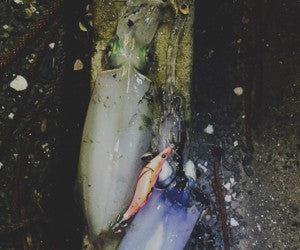Author: Michael Walkley

So the question on the mind of many at this moment is squid, why, what, where, when and how?
Well, all of this will be addressed in this blog.

So, few years ago I decided why buy bait when you can catch it youself, so off I went with an image in mind of casting a lure off the rocks in our lovely harbour and coming home covered in ink. However I was sadly mistaken it wasn’t as easy as it looked, so next I researched,purchased some gear and next time was the money shot, I started to catch. The technique I discovered was called Egiing a style in which you cast out a lightly weighted squid jig around 2.5-3.5 inch long around shallow weed beds, let it sink to the desired depth and erratically twitch it, with a lightly set drag to allow you to give it a solid jerk without tearing the lure from the squid you may have hooked from the last drop. The retrieve is intended to look like a wounded bait fish so a pause in the retrieve gives the squid a chance to hit the lure, now with squid being pack hunters it’s quite normal to see two or three squid chasing your lures.
So the question is why, what’s the fascination? Well, to be fair it’s something enjoyable to do in the quieter months, squid is fantastic bait and tastes suberb? Get some mates together toss a few lures out, have a yarn while you wait for the next wave of these slimey predators to turn up.
What to use? Well, in many cases a very light soft bait rod is adequate, but I still find them very heavy, Egging is all about finesse I for one use a rod called a Calamari Stick, Light Carbon Blank, small eyes and the perfect length for the sport, reels? smaller the better in this instance, as you want your set up to be a light as possible, I for one use a Shimano Stradic 2500 ci4 but is all comes down to personal preference.
Leader and line now this can mean the difference between catching squid and not even getting a bite, light braid is your friend from 4-8lb is preferred as with a light jig the current can affect your line as can wind so the smaller the diameter the less affected it is, and Light Fluro Carbon leader around 10lb the largest you should go, as it can still be quite snaggy around the weedy out crops.

Now the fun happens, jigs come in many sizes and patterns and if you are anything like me you want them all (haha!), but it comes down to where your fishing and how, get a selection of 2.3-3.5 inch jigs and an assortment of colours, in murky waters and night try to use the fluro colours oranges, pinks greens and lumos. In the clear daylight hours you can use mackerel and pilchard patterns, squid are predators and have big eyes and know what to look for. Brand wise is up to you. I use Yamishita but have seen success on most other brands so the choice is yours. Takapuna Topcatch and WS Lauries have a good range of Feille Japanese jigs which also work well.
Where you can do this? Well, I for one can only say around the greater Auckland area but I would expect likely success around our entire coastline.
Fish your feet is the key to success with these critters. Tamaki drive is a local hotspot to many squid fanatics, with the likes of Okahu Bay Wharf and the break wall which runs from the city right up to Ladies Bay, this easily accessible roadside area has everything a squid needs, food, shelter and current. The large rocky out crops around the yacht club fish. Well, this time of the year as the current flows past the northern point and its the same deal under the wharf lights, weed beds are visible on a low tide so go check it out in the day and plan your next trip, following around the harbour to the likes of the bay’s on the North Shore for me there’s 3 main hot spots I fish Takapuna Boat Ramp, Devonport, and Murrays Bay, all easily accessible and just by checking for ink marks on the ground you can see squid have been caught , squid ink is everywhere.
For those of you lucky enough to live further up the coast, Gulf Harbour Boat Ramp and Leigh Wharf are known for big squid, same rules apply fish the weed banks and rocky areas, they won’t be far behind.

Sure it is a debatable topic, but for me nighttime seems to be the preferred time as the lights seem to attract the squid and baitfish to an area, using a big torch or underwater lights seems to have its advantages, you will quite often see them cruising in the lights just under the surface, easy picking.
Daytime can have its moments too, clear water daytime Egging is my favourite of all, it’s challenging but rewarding as you can watch a squid leave is weedy hide out and pounce on your jig, natural colours work best in this situation.
The question I’m always asked is how?
Well, there are many techniques and the key is to find what works for you. Egiing in my opinion is the preferred method as you are enticing the squid into attacking what looks like a wounded bait fish, much like tricking a hungry snapper into eating soft bait. The technique once mastered is unquestionably the best way to catch squid. Most people I see seem to fish with use floats which as boring as it is still seems to produce, basically you cast out your float out with about a metre of trace and a lure attached, the line should run freely through the float untill it hits a crimp which stops it sinking any further and lets the current take the jig over the weed beds, an occasional twitch gives the lure a bit of life and attracts these inky creatures.

Now when the currents are too strong a standard dropper rig can be implemented, and a metre long trace with one or two jigs spaced about 400mm apart and a 1-2oz bomb sinker on the bottom and vertically jigged off a bit of structure like a wharf or rock ledge, you’ll need a minimum of 3m of depth for this to be effective.
These are the three main styles but if something else works why not try it ,I’ve seen people use a surfcasting floating rig with a sinker on the bottom with a trailing line off to the jig when fishing off the rocks and hey it works, what’s stopping you trying something new.
So get out there, give it a crack and tight lines.



Share:
Squid Time
Winter Strayline: The Key to Success